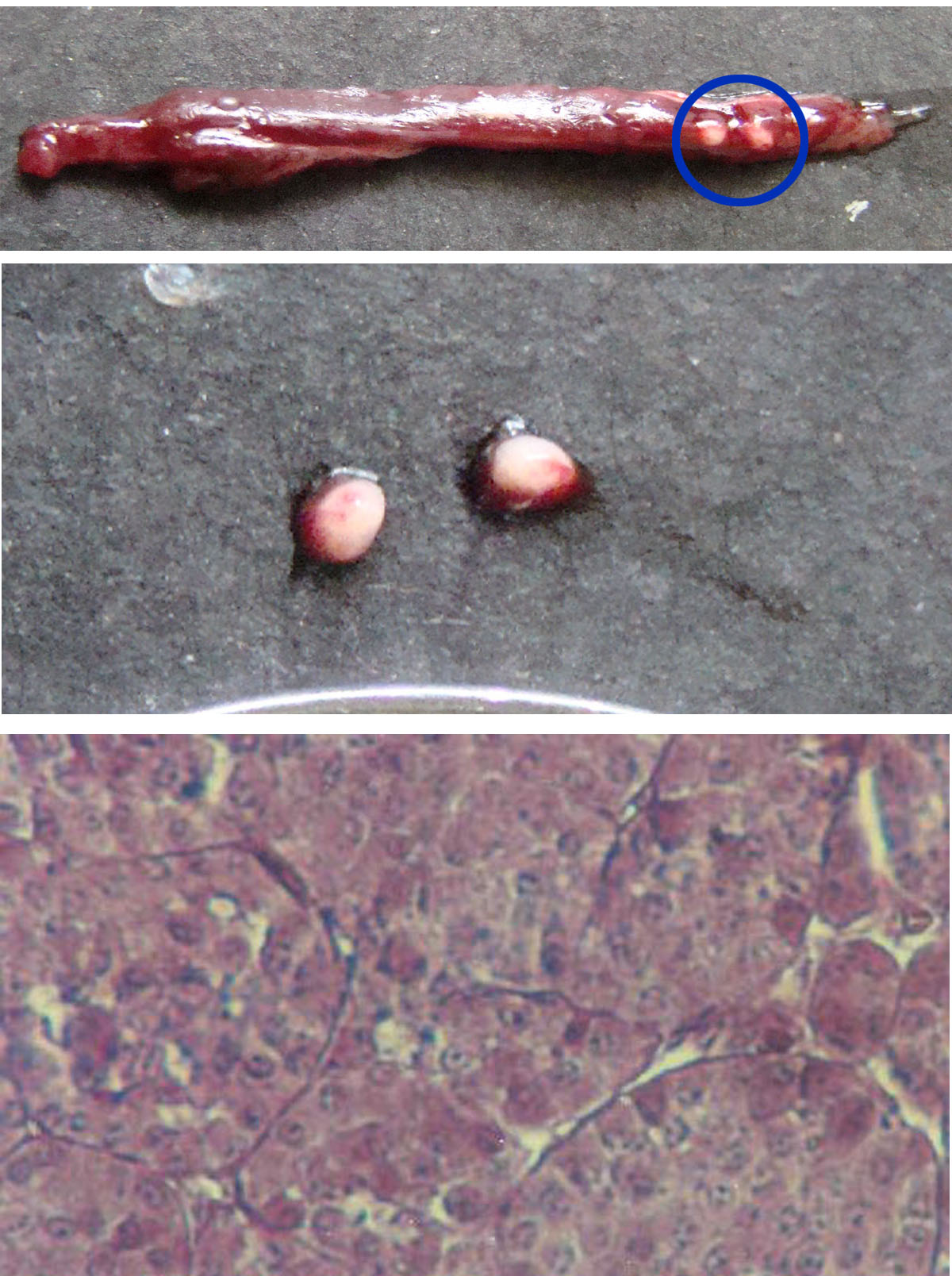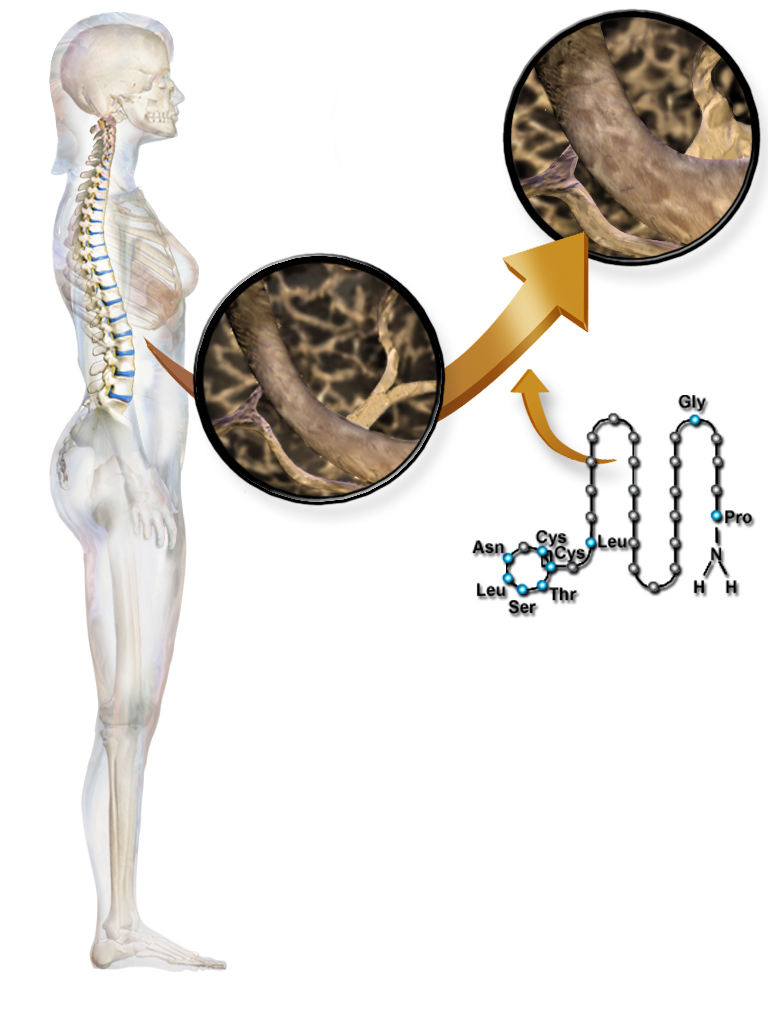|
Corpuscles Of Stannius
The corpuscles of Stannius are special endocrine organs in the kidney in fish and are responsible for maintaining calcium balance. They are found only in bony fishes. They were discovered and described by a German anatomist Hermann Friedrich Stannius in 1839. Stannius considered them as functionally similar to adrenal glands in mammals. But they have later been found to be anatomically different as they are derived from different tissues of the embryo. Structurally the corpuscles are a large number of spherical bodies separated from each other by loose connective tissues. Each body or lobule is in turn composed of several columnar cells, which contain secretory granules and are, thus, secretory in function. Each Secretory granule is spherical in shape and measures 0.5 to 1 μm in diameter. Their possible endocrine nature, i.e. producing hormone, was suspected from the complete anatomical description, and it was believed to be responsible for regulating calcium level in the blood. T ... [...More Info...] [...Related Items...] OR: [Wikipedia] [Google] [Baidu] |
Endocrine System
The endocrine system is a messenger system comprising feedback loops of the hormones released by internal glands of an organism directly into the circulatory system, regulating distant target organs. In vertebrates, the hypothalamus is the neural control center for all endocrine systems. In humans, the major endocrine glands are the thyroid gland and the adrenal glands. The study of the endocrine system and its disorders is known as endocrinology. Glands that signal each other in sequence are often referred to as an axis, such as the hypothalamic-pituitary-adrenal axis. In addition to the specialized endocrine organs mentioned above, many other organs that are part of other body systems have secondary endocrine functions, including bone, kidneys, liver, heart and gonads. For example, the kidney secretes the endocrine hormone erythropoietin. Hormones can be amino acid complexes, steroids, eicosanoids, leukotrienes, or prostaglandins. The endocrine system can be contrasted to ... [...More Info...] [...Related Items...] OR: [Wikipedia] [Google] [Baidu] |
Calcium Metabolism
Calcium metabolism is the movement and regulation of calcium ions (Ca2+) ''in'' (via the gut) and ''out'' (via the gut and kidneys) of the body, and ''between'' body compartments: the blood plasma, the extracellular and intracellular fluids, and bone. Bone acts as a calcium storage center for deposits and withdrawals as needed by the blood via continual bone remodeling. An important aspect of calcium metabolism is plasma calcium homeostasis, the regulation of calcium ions in the blood plasma within narrow limits. The level of the calcium in plasma is regulated by the hormones parathyroid hormone (PTH) and calcitonin. PTH is released by the chief cells of the parathyroid glands when the plasma calcium level falls below the normal range in order to raise it; calcitonin is released by the parafollicular cells of the thyroid gland when the plasma level of calcium is above the normal range in order to lower it. Body compartment content Calcium is the most abundant minera ... [...More Info...] [...Related Items...] OR: [Wikipedia] [Google] [Baidu] |
Osteichthyes
Osteichthyes (), popularly referred to as the bony fish, is a diverse superclass of fish that have skeletons primarily composed of bone tissue. They can be contrasted with the Chondrichthyes, which have skeletons primarily composed of cartilage. The vast majority of fish are members of Osteichthyes, which is an extremely diverse and abundant group consisting of 45 orders, and over 435 families and 28,000 species. It is the largest class of vertebrates in existence today. The group Osteichthyes is divided into the ray-finned fish ( Actinopterygii) and lobe-finned fish ( Sarcopterygii). The oldest known fossils of bony fish are about 425 million years old, which are also transitional fossils, showing a tooth pattern that is in between the tooth rows of sharks and bony fishes. Osteichthyes can be compared to Euteleostomi. In paleontology the terms are synonymous. In ichthyology the difference is that Euteleostomi presents a cladistic view which includes the terrestrial ... [...More Info...] [...Related Items...] OR: [Wikipedia] [Google] [Baidu] |
Hermann Friedrich Stannius
Hermann Friedrich Stannius (15 March 1808, Hamburg – 15 January 1883, Sachsenberg near Schwerin) was a German anatomist, physiologist and entomologist. He specialised in the insect order Diptera especially the family Dolichopodidae. Works Entomology * ''De speciebus nonnullis Mycethophila vel novis vel minus cognitis''.Bratislava, 1831. * Die europischen Arten der Zweyfluglergattung Dolichopus. ''Isis Oken'' 1831: 28–68, 122–144, 248–271, 1831. *''Beiträge zur Entomologie, besondere in Bezug auf Schlesien, gemeinschaftlich mit Schummel''. Breslau, 1832. *Über den Einfluss der Nerven auf den Blutumlauf. roriep's''Notizen aus dem Gebiete der Natur- und Heilkunde'', 1833, 36: 246–248. *Ueber einige Missbildungen an Insekten. üller's''Archiv für Anatomie, Physiologie und wissenschaftliche Medizin'', Berlin, 1835: 295–310. Medical and Physiology *''Allgemeine Pathologie''. Berlin, I, 1837. *Ueber die Einwirkung des Strychnins auf das Nervensystem. ''Archiv für ... [...More Info...] [...Related Items...] OR: [Wikipedia] [Google] [Baidu] |
Adrenal Gland
The adrenal glands (also known as suprarenal glands) are endocrine glands that produce a variety of hormones including adrenaline and the steroids aldosterone and cortisol. They are found above the kidneys. Each gland has an outer cortex which produces steroid hormones and an inner medulla. The adrenal cortex itself is divided into three main zones: the zona glomerulosa, the zona fasciculata and the zona reticularis. The adrenal cortex produces three main types of steroid hormones: mineralocorticoids, glucocorticoids, and androgens. Mineralocorticoids (such as aldosterone) produced in the zona glomerulosa help in the regulation of blood pressure and electrolyte balance. The glucocorticoids cortisol and cortisone are synthesized in the zona fasciculata; their functions include the regulation of metabolism and immune system suppression. The innermost layer of the cortex, the zona reticularis, produces androgens that are converted to fully functional sex hormones i ... [...More Info...] [...Related Items...] OR: [Wikipedia] [Google] [Baidu] |
Connective Tissue
Connective tissue is one of the four primary types of animal tissue, along with epithelial tissue, muscle tissue, and nervous tissue. It develops from the mesenchyme derived from the mesoderm the middle embryonic germ layer. Connective tissue is found in between other tissues everywhere in the body, including the nervous system. The three meninges, membranes that envelop the brain and spinal cord are composed of connective tissue. Most types of connective tissue consists of three main components: elastic and collagen fibers, ground substance, and cells. Blood, and lymph are classed as specialized fluid connective tissues that do not contain fiber. All are immersed in the body water. The cells of connective tissue include fibroblasts, adipocytes, macrophages, mast cells and leucocytes. The term "connective tissue" (in German, ''Bindegewebe'') was introduced in 1830 by Johannes Peter Müller. The tissue was already recognized as a distinct class in the 18th century. ... [...More Info...] [...Related Items...] OR: [Wikipedia] [Google] [Baidu] |
Stanniocalcin
Stanniocalcin (originally named hypocalcin or teleocalcin or parathyrin) is a family of hormones which regulate calcium and phosphate balance in the body. The first stanniocalcin discovered was from fish and was identified as the principal calcium-reducing ( hypocalcaemic) factor. It was isolated from special organs in fish called corpuscles of Stannius, hence the name stanniocalcin. Chemically, stanniocalcins are glycosylated proteins (i.e. proteins containing carbohydrate, or glycoproteins) having a molecular mass of 50 kDa. They exist in molecular pairs (homodimers) and are joined together by disulfide linkage. Stanniocalcins are made up of approximately 250 amino acids. Discovery In 1839, the German anatomist Hermann Friedrich Stannius discovered a pair of novel structures inside the kidneys of sturgeon and bony fishes. He believed that they were a kind of adrenal gland (found in mammals) in these fishes. In 1896, the French physiologist A. Petit demonstrated that removal of ... [...More Info...] [...Related Items...] OR: [Wikipedia] [Google] [Baidu] |
STC1
Stanniocalcin-1 is a glycoprotein, a homologue of a hormone stanniocalcin, first discovered in bony fishes. In humans it is encoded by the ''STC1'' gene. Function This gene encodes a secreted, homodimeric glycoprotein that is expressed in a wide variety of tissues and may have autocrine or paracrine functions. The only known molecular function of human Stanniocalcin-1 to date is a SUMO E3 ubiquitin ligase activity in the SUMOylation cycle. However, STC1 interacts with many proteins in the cytoplasm, mitochondria, endoplasmatic reticulum, and in dot-like fashion in the cell nucleus. The N-terminal region of STC1 is the function region which is responsible to establish the interaction with its partners, including SUMO1. Low-resolution studies shows that STC1 is an anti-parallel homodimer in solution and the cysteine 202 is responsible for its dimerization. All the 5 disulfide bonds of human STC1 are conserved and have the same profile of fish STC. The gene contains a 5' UTR rich ... [...More Info...] [...Related Items...] OR: [Wikipedia] [Google] [Baidu] |
Parathyroid Hormone
Parathyroid hormone (PTH), also called parathormone or parathyrin, is a peptide hormone secreted by the parathyroid glands that regulates the serum calcium concentration through its effects on bone, kidney, and intestine. PTH influences bone remodeling, which is an ongoing process in which bone tissue is alternately resorbed and rebuilt over time. PTH is secreted in response to low blood serum calcium (Ca2+) levels. PTH indirectly stimulates osteoclast activity within the bone matrix ( osteon), in an effort to release more ionic calcium (Ca2+) into the blood to elevate a low serum calcium level. The bones act as a (metaphorical) "bank of calcium" from which the body can make "withdrawals" as needed to keep the amount of calcium in the blood at appropriate levels despite the ever-present challenges of metabolism, stress, and nutritional variations. PTH is "a key that unlocks the bank vault" to remove the calcium. PTH is secreted primarily by the chief cells of the para ... [...More Info...] [...Related Items...] OR: [Wikipedia] [Google] [Baidu] |
Calcitonin
Calcitonin is a 32 amino acid peptide hormone secreted by parafollicular cells (also known as C cells) of the thyroid (or endostyle) in humans and other chordates. in the ultimopharyngeal body. It acts to reduce blood calcium (Ca2+), opposing the effects of parathyroid hormone (PTH). Its importance in humans has not been as well established as its importance in other animals, as its function is usually not significant in the regulation of normal calcium homeostasis. It belongs to the calcitonin-like protein family. Historically calcitonin has also been called thyrocalcitonin. Biosynthesis and regulation Calcitonin is formed by the proteolytic cleavage of a larger prepropeptide, which is the product of the CALC1 gene (). It is functionally an antagonist with PTH and Vitamin D3. The CALC1 gene belongs to a superfamily of related protein hormone precursors including islet amyloid precursor protein, calcitonin gene-related peptide, and the precursor of adrenomedullin. Secre ... [...More Info...] [...Related Items...] OR: [Wikipedia] [Google] [Baidu] |
Bony Fish
Osteichthyes (), popularly referred to as the bony fish, is a diverse superclass of fish that have skeletons primarily composed of bone tissue. They can be contrasted with the Chondrichthyes, which have skeletons primarily composed of cartilage. The vast majority of fish are members of Osteichthyes, which is an extremely diverse and abundant group consisting of 45 orders, and over 435 families and 28,000 species. It is the largest class of vertebrates in existence today. The group Osteichthyes is divided into the ray-finned fish ( Actinopterygii) and lobe-finned fish ( Sarcopterygii). The oldest known fossils of bony fish are about 425 million years old, which are also transitional fossils, showing a tooth pattern that is in between the tooth rows of sharks and bony fishes. Osteichthyes can be compared to Euteleostomi. In paleontology the terms are synonymous. In ichthyology the difference is that Euteleostomi presents a cladistic view which includes the terrestrial ... [...More Info...] [...Related Items...] OR: [Wikipedia] [Google] [Baidu] |








